How can you treat pain in cats?
If your cat is showing signs of being in pain (see Pain Recognition if you’re not sure), speak with your vet to try to figure out exactly where they are painful and what may have caused it as the best way to resolve pain is to take away the underlying cause. Although that sadly isn’t always possible, especially for our older feline friends with chronic pain, there are fortunately a wide range of treatments options available to them.
Note – not all vets will offer all options at first, or perhaps ever, as each vet is entitled to their own professional opinion. Please have an honest conversation with your veterinary surgeon about your cat and how you can get them the pain care they deserve, seeking a second opinion or referral to another clinic if necessary.
Drug therapies
NSAIDs

Non-steroidal anti-inflammatory drugs (NSAIDs) are effective in the treatment of pain due to their anti-inflammatory properties. They reduce the inflammation associated with many musculoskeletal conditions including osteoarthritis, cystitis and dental disease. Meloxicam (Metacam or Loxicom) and robenacoxib (Onsior) are two drugs in this class that we most frequently use. They are very effective and act quickly to reduce pain, even within a few hours. It is very important that they are used only at the dose prescribed as otherwise they can sometimes have some effects on kidney and liver function and also cause gastrointestinal upsets. We recommend regular monitoring of patients on these drugs and in long term use we always try to adjust the amount given to the lowest effective dose to avoid adverse effects. These drugs come in tablet and liquid form.
Frunevetmab (Solensia)
A relatively new addition, Solensia is possibly the most important advance in feline medicine in the past decade. Instead of daily oral medication, all that is required is a monthly injection under the skin, so it’s great for cats that don’t tolerate medication in their food. Solensia is a monoclonal antibody injection which blocks nerve growth factor, a key pain mediator in the body (part of the pathway that tells the brain to feel pain). It is licensed for arthritis pain, but anecdotal evidence has shown it to be effective for other types of pain too.
Not all cats respond to Solensia, but in our experience, the vast majority do and the results can be life-changing. There are no known contraindications, so it can be used with other medications, and does not pose the same risks to the liver or kidneys as NSAIDs, making it not only an easy option but a safe one too. This is new technology, and therefore comes at a cost, but it has already proven itself as an incredibly effective way of maintaining comfort in our feline friends.
Opioids
Opioids are considered to be some of the strongest painkillers available. They act on special areas in the brain and spinal cord to block the transmission of pain signals. They are used to treat severe pain after surgery or injury and can also help in the management of some types of chronic pain. We often use a drug within this class, called buprenorphine, for dental pain (including before and after extractions), severe musculoskeletal disease and in the management of acute and chronic pancreatitis. We often give this drug by injection but it can be also be effective when just dropped onto the gums and therefore can be easy to administer in most cats.
Tramadol is another opioid drug which has been used in cats. Response can be variable and sometimes more side effects seen, in particular dysphoria (a profound state of unease) and therefore we tend to choose other medications first.
Adjunct medications
Although chronic pain may be adequately controlled in some cats using a single agent, such as an NSAID or opioid, some cats may need a combination of both. Cats with severe pain may also benefit from other adjunctive medications, listed below are some such medications which are used.
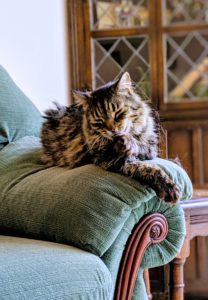
Gabapentin/Pregabalin
These two drugs are effective in reducing chronic pain and in particular neuropathic pain. This is the burning or tingling sensation caused by damaged nerves and can be experienced in some cases of arthritis or dental pain. They can also prevent hyperalgesia which is an increased sensitivity to pain response. They have mild anti-anxiety effects and therefore can also help some of our more nervous patients. Both drugs are available as tablets or a liquid.
Amantadine
Amantadine is an antiviral drug but it has the side effect of providing pain relief. It is generally used alongside other medications to treat chronic pain in cats and is of particular benefit for neuropathic pain. It is not usually effective when administered alone but it can improve pain control when administered in conjunction with NSAIDs. It can also be combined with opioids and other adjuncts to enhance their effects.
Amitriptyline
This is a human anti-depressant drug but is again usually used in conjunction with NSAIDs and opioids in the treatment of feline chronic pain, particularly of neuropathic origin.
Steroids
Steroids have strong anti-inflammatory properties and can help to reduce the pain associated with significant inflammation, in particular that associated with oral cavity disease. They are sometimes also used to help with cancer pain. Although steroids are very effective at treating inflammation which in itself can be painful, they are not considered to have much pain killing action on their own and are therefore most often used in combination with other medications.
Cartrophen Vet (pentosan polysulfate sodium)
This is a disease-modifying osteoarthritis drug (DMOAD). It acts to preserve the joint cartilage thereby improving the health of arthritic joints. It is given as a course of weekly injections for four weeks which can be repeated two to three times a year. There are few side effects or contraindications which makes it a good choice for some of our more elderly patients and also for those owners who are wishing to avoid some of the drug therapies. It cannot be given alongside NSAIDs and steroids but it can be used either alone or with other adjunct medications and complementary therapies in the control of osteoarthritis. There is also some more recent evidence that it could be helpful in some cases of chronic cystitis in cats.
Nutraceuticals
These are also known as joint supplements and typically contain compounds such as glucosamine and chondroitin. The theory behind their use is that they provide building blocks to help repair damaged cartilage within an arthritic joint, however there is only anecdotal evidence to suggest they improve clinical signs associated with degenerative joint disease. There are also some similar supplements available to help improve the quality of the bladder lining which can help in feline cystitis.
CBD
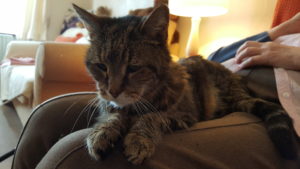
Cannabidiol (CBD) is one of many chemical compounds known as cannabinoids found in the cannabis plant. Cannabinoids work on special receptors within a specialized system in the brain called the endocannabinoid system (ECS). This system has many functions including helping to regulate pain sensation and pain management. CBD is believed to help with chronic pain management by acting through this system and does not work on the psychoactive receptors of the brain, therefore not having mind-altering effects. In people CBD is still classed as a food additive, however, in veterinary medicine it can only be obtained with a veterinary prescription from a reliable source. Its use in pets is only just starting to become more known. Therefore, it is used only in patients who have had chronic disease for several years and almost every other pain killer or physical therapy has been tried but they are still struggling, or in patients that really can’t tolerate other oral medicines as it is applied to the gumline.
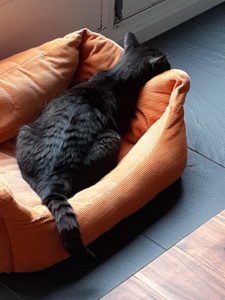
There is a fatty acid called palmitoylethanolamide (PEA) which exerts a variety of biological functions relating to chronic pain and inflammation. In acute and chronic inflammation levels of PEA have been shown to be reduced along with an imbalance in the ECS. It is also believed to exert a cannabinoid-like effect and therefore has also been taken as a dietary supplement to help with pain management in people. However, its availability for use in animals is limited in this country at this time.
Currently, there is no licensed product available, and vets have been told specifically by their regulating body NOT to recommend this option to patients so this is the one option where it would be acceptable to receive a solid ‘no’ from your vet and perhaps with good reason due to a lack of evidence. We sincerely hope this will change in the near future however!
Complementary therapies
Acupuncture
Acupuncture works by blocking the pain messages and also encourages the body to produce more of its natural painkilling substances, serotonin and endorphins. We have been seeing some wonderful results in our patients with arthritic conditions. Acupuncture can also be helpful in treating a number of other painful conditions, such as cystitis, and even some functional disorders, for example, constipation. Acupuncture helps to reduce the suffering associated with pain and therefore brings about an improved sense of wellbeing and better quality of life. It can be used alone or alongside other conventional therapies and can potentially help to reduce the amount of medications required.
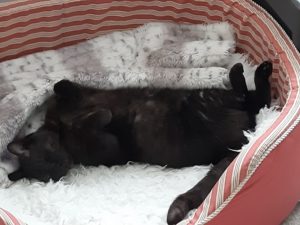
Electroacupuncture involves attaching a small electric current to the acupuncture needles which produces a stronger sensation and is sometimes used when a longer lasting effect is required.
Physiotherapy
Physiotherapy is often referred to as the treatment of disease, injury or deformity by physical methods. These can include manual manipulation, massage and remedial exercises. These can help to relieve muscular pain, improve strength and range of movement, stimulate circulation and promote well-being and relaxation.
Sometimes electro and thermal therapies are also used, for example, laser and other red light therapies. These help to provide pain relief, reduce swelling and inflammation, improve muscle tone and promote tissue healing.
Hydrotherapy is water based exercise and can also be used for relieving the pain of musculoskeletal problems such as osteoarthritis. It can also be beneficial following surgery and injury to help return to normal function. Contrary to popular belief cats can actually be very good at swimming and some actually enjoy water. The buoyancy of the water reduces the load on the cats’ joints which allows them to exercise with reduced pain and therefore a better range of movement. This helps with strengthening muscles. The warm water helps reduce muscle spasm and promotes blood circulation, which in turn help promote healing and reduces swelling.
Environmental Modifications
Finally, there are many things that you can do at home to help keep your cat comfortable throughout the day, in addition to all of the other methods listed above:
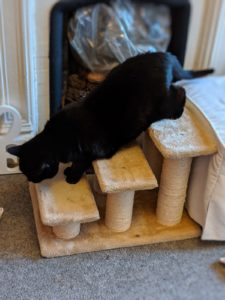
- Make sure they can easily access all of their favourite things. Keep food and water bowls on the floor, but slightly elevated so they don’t have to extend their neck down to eat or drink. Make sure litter trays are large enough to turn around easily, and have at least one area with a low edge where they can get in and out without too much effort (you may want to take the lid off of covered trays). Create steps up to their favourite resting places for easy access.
- Heat is a wonderful way to ease sore joints. There are many options available, from electric pet heat pads to hot water bottles to self-reflecting heat mats. Be sure to cover the heat source with a layer of blankets to keep your cat from contacting it directly, and NEVER put an active heat source under a cat that cannot easily get up and move away from it as this can cause burns to the skin, even if it doesn’t feel particularly hot to us.
- Like physiotherapy, gentle play can keep sore joints moving, and is good for their (and your own!) overall mood too
- If your cat has pain in the mouth, try giving them a mousse or pate type food, or mash their existing food up with a fork or blender. Adding a bit of water can turn it into more of a soup that can be easier to eat.
Summary
Chronic pain management in cats can present many challenges for vets and pet owners. However, with a range of medications either alone or together along with complementary therapies, patients can benefit from effective pain relief. Safety of drug therapy is maintained by stabilising your cat’s overall health, individualizing and adjusting drug doses as needed and closely monitoring for signs of improvement or adverse reactions.
Our team at The Cat Doctor will assess your cat’s individual needs and are here to help you make informed decision about the best treatment options for you and your cat.
Please note – human medications such as ibuprofen and paracetamol are toxic to cats. NEVER give your cat medication that has not been specifically prescribed for them or you could cause them serious harm or even death.

